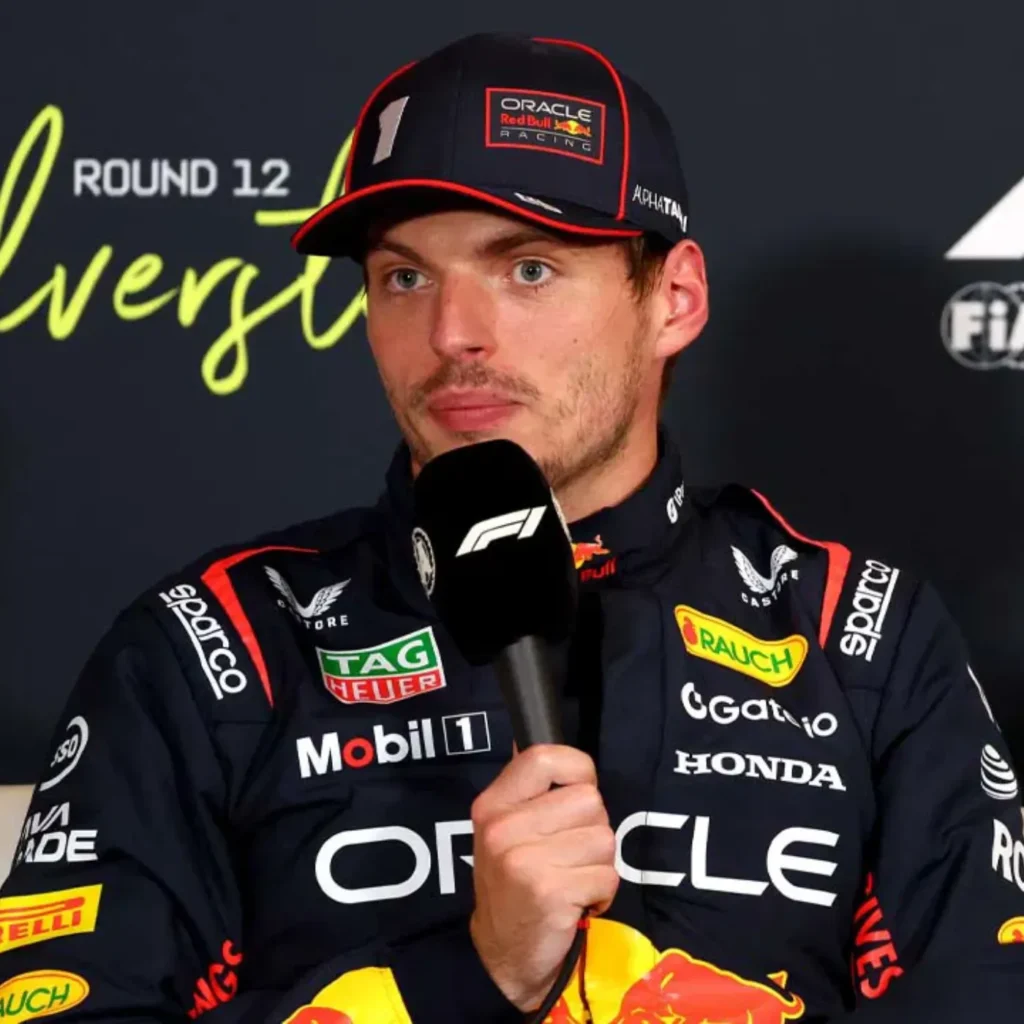“We Miscalculated—Badly”: Red Bull’s Secret Error That Could Cost Verstappen the Championship
Content Manager July 10, 2025 0
The Cracks in the Kingdom
No one saw it coming—not the fans, not the analysts, not even Max Verstappen himself. What was supposed to be a routine march toward yet another world title has turned into something darker. Something murky. And now, as whispers grow louder and eyes shift nervously around the paddock, a single phrase has detonated like a thunderclap across the Formula One world:
“We miscalculated—badly.”
Those words, reportedly uttered by a senior Red Bull engineer during the British Grand Prix weekend, may go down as the moment the dynasty wobbled. Until that race, Verstappen had appeared nearly invincible—winning with one hand on the wheel, outthinking rivals in strategy meetings, and making even the best drivers on the grid look ordinary. But Silverstone changed everything.
And what’s worse—Silverstone might have only revealed the tip of a catastrophic iceberg.
In the past, even when Red Bull had an off weekend, they had answers. They adjusted. They responded. But this time? They looked confused. Defensive. Out of sync with reality. The cold efficiency we’ve come to expect from Adrian Newey’s design room and Christian Horner’s race wall had vanished—replaced by uncertainty, denials, and behind-the-scenes scrambling.
So what exactly did they get wrong?
And is this the beginning of the end of the Verstappen era?
The Error They Can’t Admit
What makes this moment so alarming isn’t just that Red Bull made a mistake. Every team in Formula One missteps—it’s the nature of elite motorsport. What’s different now is that Red Bull’s mistake might be fundamental—embedded in the very DNA of the RB20’s mid-season evolution.

Behind the dominant façade, team insiders have now confirmed that Red Bull’s 2024 development path took a sharp turn after the first three flyaway rounds. Confident in their early-season lead, the team decided to double down on aerodynamic efficiency. The plan? Sacrifice a little cornering stability in exchange for superior straight-line speed and DRS dominance—a formula that had worked wonders in 2022 and 2023.
But something changed in the sport’s ecosystem.
The new Pirelli tire construction, introduced mid-season to combat increasing cornering loads, had unintended consequences—especially for cars like the RB20 that depend on ultra-sensitive floor sealing and rake-sensitive balance. Red Bull’s floor upgrades, designed using simulator data and wind tunnel sessions limited by the lingering cost cap penalty, failed to account for a sharp increase in rear tire temperature sensitivity.
In simple terms, they thought they’d gained grip and stability—but they hadn’t.
Instead, what they created was a car that behaved beautifully in simulations and even during qualifying laps but fell apart over long stints. This flaw remained invisible until the conditions aligned—as they did at Silverstone and Barcelona—where Verstappen’s pace crumbled under pressure.
For the first time in years, Red Bull had delivered a car that looked quick… but was secretly fragile.
And now, rivals smell blood.
The Rise of McLaren and the Ghost of 2021
If the mid-season chaos feels familiar, it should. In 2021, Verstappen and Red Bull found themselves in a title fight where every millimeter mattered, and the FIA’s interpretation of technical gray areas shaped championship outcomes. Back then, Mercedes pushed development to the brink—and when they figured out how to unlock more rear-end grip in the final stretch, Red Bull never fully recovered.
This year, the parallels are eerie.
McLaren, once written off as a midfield team, has surged with astonishing pace. Their in-season development curve has outpaced even Ferrari, and their car’s strength in high-speed corners—combined with low degradation—is now proving decisive.
Lando Norris has already taken the fight directly to Verstappen in Austria and Britain. And unlike Ferrari or Mercedes in previous years, McLaren is fearless. They don’t just want to win—they want to break the illusion of Red Bull’s invincibility.
And they’re not alone.
Even Mercedes, dormant for most of 2023, is beginning to claw its way back into relevance. With a radically overhauled suspension concept and revised weight distribution, they’ve begun finding lap time where it matters: in race trim, on worn tires, in turbulent air.
Suddenly, the championship isn’t a coronation. It’s a war.
And Verstappen?
He’s caught in the middle—with a car that no longer does what it’s told.
The Internal Meltdown They’re Hiding
While Red Bull publicly shrugs off concerns, the internal turmoil is growing. Two separate reports from European journalists now claim that the team has split into factions—with one group pushing for a rapid redesign of the rear floor and another urging a pause to avoid triggering a cascade of balance issues.
Adrian Newey, still the sport’s most feared technical mind, has reportedly grown distant from day-to-day decisions as he explores future opportunities—perhaps even a move to Aston Martin or a return to Ferrari before retirement. That vacuum in decision-making has left the team leaning heavily on simulator data—data that, by all accounts, is no longer correlating with track reality.
Verstappen, once famously aloof from technical politics, is now deeply engaged in the process—holding late-night debriefs with engineers and requesting old spec parts be reinstalled for comparison tests.
And yet, the more they test… the less sense things make.
One insider called it a “paralysis loop”—where every fix creates a new instability.
They upgraded the floor. Tire wear worsened.
They altered the suspension kinematics. Corner exit traction fell.
They trimmed rear wing drag. The DRS benefit disappeared.
It’s not just a case of fixing a single flaw. It’s a domino collapse of design assumptions.
And the deeper they dig, the more they realize: the RB20 is no longer predictable.
Could the FIA Be Closing In?

There’s another layer of mystery here—one that no one at Red Bull will speak of publicly.
According to multiple independent sources, rival teams have begun privately assembling technical dossiers on Red Bull’s floor behavior. They believe the car’s rear ride height changes more aggressively under load than should be legally possible—a possible violation of flexi-floor regulations.
So far, no formal protest has been filed. But it’s coming.
In fact, some believe that FIA’s sudden interest in floor deflection compliance checks post-Barcelona was not random. Quietly, Red Bull has been subjected to several on-site inspections—not just of their car, but of their modeling data.
If the FIA finds that the RB20 used a legally gray component to pass static tests while deforming under dynamic loads… they could issue a points penalty. Or worse.
And that’s why Red Bull’s silence is growing louder.
It’s not just about winning races anymore.
It’s about avoiding an investigation that could rewrite the season’s outcome overnight.
What Max Verstappen Really Thinks
Max Verstappen isn’t one to panic. His composure is legendary. But there is a difference between calm… and cold silence.
In his last three post-race interviews, Verstappen has spoken with increasing detachment. He hasn’t praised the car. He hasn’t praised the strategy. And after the British Grand Prix, when asked if the team still had the championship under control, he simply said, We’ll see.”
That’s not Max Verstappen.
That’s a driver who’s losing faith.
The Max we saw in 2022 and 2023 would have laughed at the suggestion of a championship challenge. But now? He’s watching McLaren develop faster. He’s watching Ferrari qualify better. He’s watching Red Bull improvise—something he’s never trusted.
And if Verstappen decides that the team no longer has the tools to deliver, his contract won’t matter.
Because Verstappen doesn’t fear the unknown.
He only fears being held back.
And right now, Red Bull looks less like a rocket… and more like an anchor.
The Road Ahead
With Hungary and Belgium looming, the pressure on Red Bull is at critical mass. These next two circuits—one a tight, technical track, the other a high-speed monster—will reveal the truth.
If Red Bull rebounds with a dominant pace, they can silence the doubters, reassert control, and bury the whispers about internal chaos and technical gray areas.
But what if the problems persist?
If Verstappen finishes behind Norris again?
If the car’s balance deteriorates under high-fuel loads?
Then the façade will shatter.
And the phrase that was once a careless whisper—“We “miscalculated—badly”—will ”become a headline burned into the legacy of this season.
Because in Formula One, dominance is fleeting.
One week you’re rewriting history.
The next, you’re trying to survive it.
And for Red Bull Racing, the survival clock is ticking.




